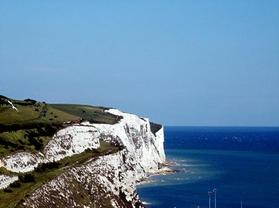
The sun was out bright, breakfast done, and we were ready to head off for the day. We headed off down the coast and the first village we were looking for was Rye. Rye is a mix of cobbled stone streets, towers, and half-timbered buildings. By half timbered buildings, I mean that the bottom half are stone, and the top, “black timber”… There is a small river, that has a “lock” system in it. Because of the tides of the English Channel, the rise and fall of the tide would just about drain the river, so about halfway through the village, the drop of the tide leaves everything high and dry and on the other side of the “lock”, it has water as usual. The first impression, is this is a “artsy” type of village, and you would be right on…hippish and artsy… Then on to Dover. Just over 2 hours out from Battle, is Dover (that’s Bumble Bee time…). Just west of Dover is Folkestone. This is were the “Chunnel” is located. The Bullet Train runs from London to Paris, through this Chunnel (Channel Tunnel), under the English Channel. Just as you pull into the city of Dover, your eyes come in contact with the Dover Castle and Fortress high on the hill. This HUGE complex is now and I’m sure centuries ago as well, is and was impressive.
Dover is known for it’s “White Cliffs”, but now that I’ve been there, it will always be the fortress and the underground caves that make Dover. The castle and it’s fortress, is thanks to King Henry II, back in the 12th century. Since that time, Dover and the Dover Castle / Fortress, has seen many significant battles. From the 13th century to WWII. The chalk cliffs of Dover have many tunnels dug into them, and all of these have been used to house armies. In the case of WWII, the English had a “Top Secret” Intelligence network that led the rescue of over 300,000 men that were caught in a trap in France. It was also the location, while receiving constant shelling from the German artillery in France, served as a major partner in the D-Day invasion in 1944. We not only took a self guided tour of the castle, walls, grounds, and the 13th century Saxton church, we had a guided tour of about 30 percent of the underground tunnels. That was all they would allow us to see. We toured 3 levels of tunnels, which included the mapping rooms, communications rooms, hospital, and some of the kitchen and crew quarters. The Heritage Group was fortunate in getting back some of the original equipment, including planning tables, hospital equipment, and phone communications systems, just to finish this fine site. I must say, this was quite a day… When we got back, one of our neighbors here had spent the day of watching professional tennis. They watched the women’s preliminary games to Wimbledon. Well, you can’t be everywhere at once… Tomorrow…London…
